ISSN 0976 - 0075
Madhumeha is a common problem that is tackled everyday by many healthcare workers throughout and it is rapidly increasing around the world. The economic, social and public health burden of its complications are enormous. Complications of Madhumeha produces surgical impacts like Chronic Balanitis, Carbuncle, Diabetic ulcer, Diabetic foot, Abscess , Emphysematous Cholecystitis, Emphysematous pyelonephritis, Necrotising fasciitis, Fournier’s gangrene and fungal infections e g. candidiasis and mucormycosis. Such complications of diabetes are due to micro vascular changes involving the capillaries of retina, kidneys and peripheral nerves; macrovascular changes characterized by atherosclerotic lesions of the coronary and peripheral arterial circulation; diabetic neuropathy and infection in glucose laiden tissue. Accelerating factors for development of such conditions in diabetes includes smoking, elevated cholesterol levels, obesity, high blood pressure and lack of regular exercise.
Amongst all most devastating complication of diabetes is Diabetic foot. In Shushrut Samhita, diabetic foot is related with ‘Madhumehaj Vrana’. During its description Shushrut stated that the management of these vranas are Kashtasadhya . According to Shushrut , meda and rakta along with other dosha and dushya lead to the formation of prameha pidaka which later if ignored converted to non healing wounds and also further specified that wounds over lower limbs are difficult to heal while the classic pathological triad of diabetic foot includes vascular disease, neuropathy and infection due to excess of sugar laiden tissue.
Current treatment of its complications involves multidisciplinary team approach such as control of underlying disease and management of the wounds using debridement, different wound dressings like VAC dressings which redistribute pressure off the wound or local applications of various formulations like as described in texts of Ayurveda. Most of the difficult wounds can be completely cured ending up with skin grafting once the diabetes of the patient is well controlled
Key words : Diabetic foot , Ropan tail , VAC dressing
Introduction :
Madhumeha is a common problem that is tackled everyday by many healthcare workers throughout and it is rapidly increasing around the world.Complications of Madhumeha produces surgical impacts like Chronic Balanitis, Carbuncle, Diabetic ulcer, Diabetic foot, Abscess , Emphysematous Cholecystitis, Emphysematous pyelonephritis, Necrotising fasciitis, Fournier’s gangrene and fungal infections e g. candidiasis and mucormycosis;
Complications of diabetes are due to Micro vascular changes involving the capillaries of retina, kidneys and peripheral nerves and Macro vascular changesare due to atheroma formation ; diabetic neuropathy and infection in glucose Leiden tissue.
In Shushrut Samhita, diabetic foot is related with ‘Madhumehaj Vrana’ and Acharya Shushrut stated that the management of these vranas are Kashtasadhya .
Samprapti = Meda + Rakta+ Dosha+ Dushya =“ Prameha Pidaka”
if ignored = Non Healing wounds. Also further specified that wounds over lower limbs are difficult to heal.
Case study :
Lab investigations of both the patients were compared
|
|
Patient A |
Patient B |
|
CBC |
12/6900/3.98(n54%, l 40%) |
13/7500/2.89(n67%, l 34%) |
|
ESR |
3 |
7 |
|
BSL(R) |
275 |
280 |
|
BSL(F) |
175 |
168 |
|
BSL(PP) |
300 |
315 |
|
HbA1c |
8 |
7.6 |
X ray left foot was within normal limits in both the cases.
Materials and Methods:
A) Bahya chikitsa : Terpentine for 1st day. And normal saline for cleaning of terpentine. Then wound dressing was done with Ropan tail= Each 10ml Sidhha Tail. Contents = Triphala -0.937gm, Haridra(embelia officinalis)-0.625gm, Kadunimba(azadiracta indica)-.625gm, Kadechirayit(swertia chirata)-0.625gm,Ushir(vetiveria zizanoides)-0.312gm, Base= Til tail(sesame oil)-10ml -Bhav Prakash.
B) Abhyantar chikitsa = Triphala guggulu 2tds, Aroghyavardhini 2tds, Tapyadi loha 2tds.
Methodology:
Physician opinion taken and antihyperglycemic treatment along with diabetic diet was started to both group patients. The wound of diabetic foot of both A and B patients was initially treated with terpentine oil to remove the maggots in first day followed by daily vrana dhavan with normal saline; out of that In Patient A application of Ropan tail with gauze was done.


Fig.1.1 Wound with maggots before and after cleaning with turpentine oil
Observation :
Disluffing was noted from the 4th day of dressing. Daily dressing was continued with the Ropan tail for 2 weeks. Formation of Granulation tissue was observed From 1st week onwards with minimal wound sluff. Fig.1.2.Wound was healthy without any foul smell and discharge at the end of 2nd week.
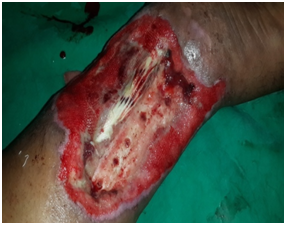
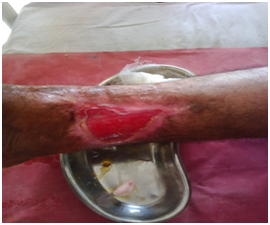
Fig. 1.2 Wound after 7th and 14th day of ropan tail application
After Ropan tail application till 3 weeks discharge and slough was reduced significantly. Then as the surface area of the wound was large skin grafting was done with the partial thickness graft taken from anterior aspect of the left thigh after 3rd week. Complete wound healing was observed by 6 th week(fig 1.3)
Discussion :
Maggots over the wound itself helps to remove sluff from the wound by engulfing debris and putrefied tissue.Contents of Ropan tail include tikta ruksha and ushna gunatmak dravya having krumighna, vishghna activity which helps to get rid off bacterial infections. Ruksha guna is responsible for absorption of the discharge from diabetic wound causing shoshan of vikrut vransrav from dushya such as kleda, meda. Siddha Tail helps to penetrate the ropan drvyas in sukshma srotasas and produses shodhan as well as ropan effect in the wound.
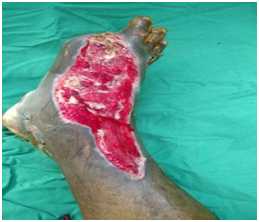
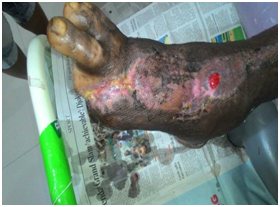
Fig.1.3 Healing of the wound by ropan tail followed by skin grafting
Now in case of patient B Negative pressure wound therapy (NPWT) has been applied.
In this therapy, Vaccum draws out the fluid from wounds to make them dry by reducing excessive discharge hence reducing soiling and wetting the dressings frequently. It accelerates wound healing by increasing local blood flow, formation of granulation tissue and decreased bacterial colonization that means they help to transfer the wound from gas gangrene to wet gangrene, from wet gangrene to dry gangrene by maintaining aeration within the wound.
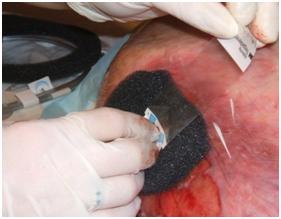
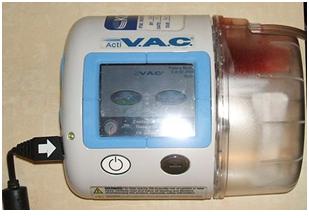
Fig.1.4 Application of sealed with occlusive dressing fig. 1.5 VAC MACHINE ( Pressure = 100 to 150 mmhg which intented to contain vaccum at wound site gives drainage to the wound
Advantages:
This VAC dressing helps in faster wound healing, decreases overall hospitalization and avoids the additional morbidity of chronic wounds.May be applied continuously and intermittently depending upon the type of wound.Dressing can be changed two to three times per week.
C.I. = Malignancy, untreated osteomylitis, non enteric and unexplored fistulas, necrotic tissue with escher formation.

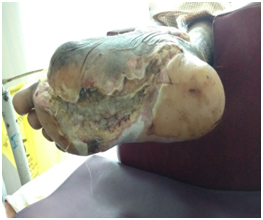
Fig. 1.6 Slough over the diabetic wound
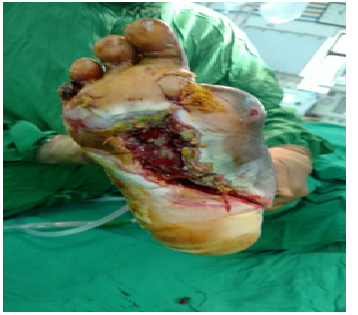
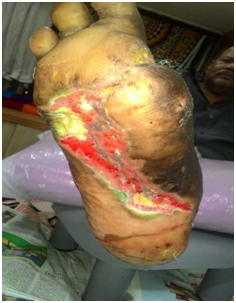
Fig. 1.7 Healing of the wound by VAC dressing followed by skin grafting
Some cases of complicated diabetic foot are mentioned below,
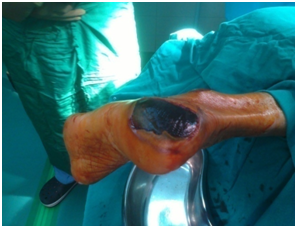
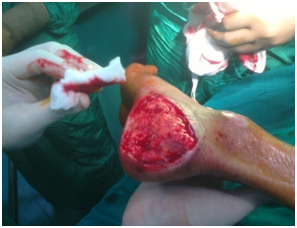
Fid. 1.7 Debridment of diabetic foot wound with escher
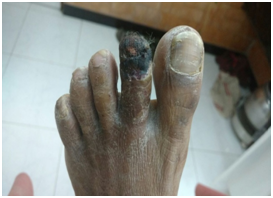
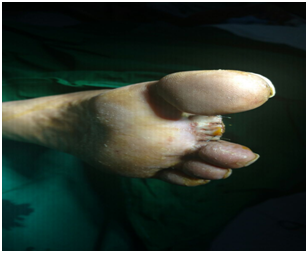
Conclusion :
Although modern techniques play key role in healing complicated diabetic wounds; they have high cost effectivety and require proper maintenance of vacuum pressure all the time within the wound. Effect of Ropan tail gives both benefits of shodhan and ropan to the wound. It is less cost effective and it Can be applied like a normal wound dressing without requirement of any specific devices.
*Assistant professor, Shalya Tantra,Dr . D. Y. Patil College of Ayurved and Research centre, Pune.
Acknowledgement
Author wishes sincere thanks to Dr. Tushar Rege, Dr. Dhimant Goleria and Dr. Bhushan sanghavi who helped to learn and apply NPWT technique in case of diabetic foot wound.
Also sincere thanks are due to sushrusha citizen cooperative hospital Dadar (w)and
Dr. D. Y. Patil college of Ayurveda and research centre ,pimpri, pune for their help to complete the study
References :